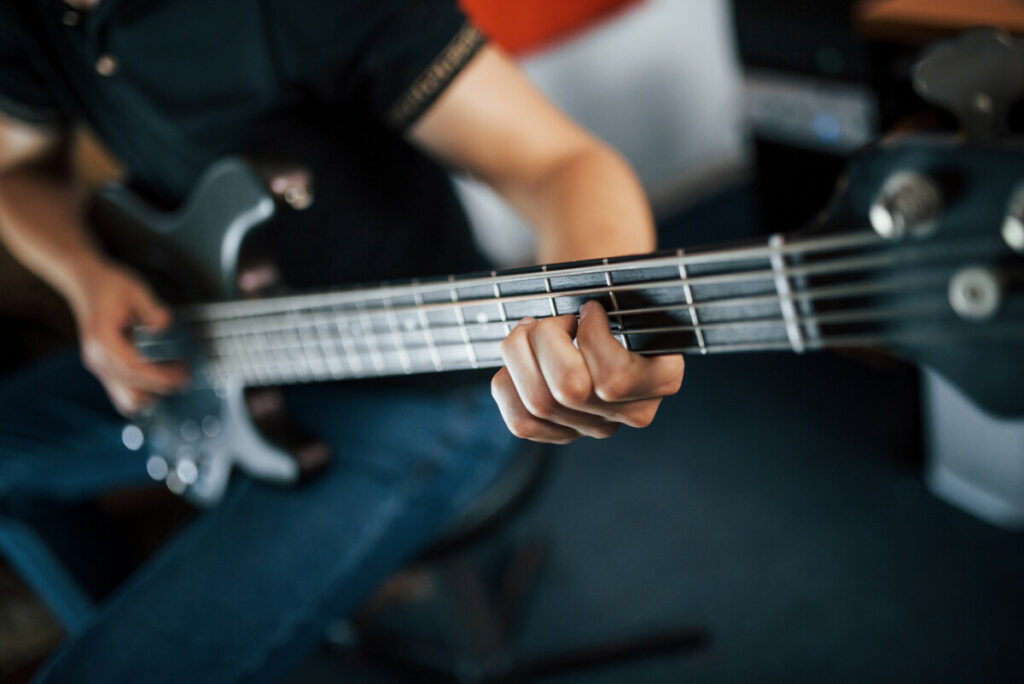You know the old adage, ‘It’s all in the wrist’? Well, let me tell you something – it hits right on target when we’re talking about playing bass guitar. To unlock your full potential as a bassist, getting your grip and holding down a pat is absolutely crucial.
In this piece, I’ll take you through every essential element for mastering that perfect technique — from understanding its structure to striking an optimal posture and balance. So gear up because we are going deep into the nitty-gritty of holding a bass guitar like a true rockstar!
Table of Contents
What You Should Know

Get your hands on the right gear before you even think about picking up that bass guitar. You’re gonna need a rocking bass, a sturdy strap, and some picks to start shredding those groovy lines. Choosing the perfect bass guitar for beginners is all about finding something that vibes with your unique style of playing and fits within your budget boundaries. Tight on cash? No worries! Grabbing an affordable second-hand bass can be just as good.
Before diving headfirst into creating epic tunes, make sure you’ve got tuning down pat – it’s essential for hitting those notes spot-on every time. This step will give you a real feel for manipulating the instrument while ensuring each note resonates perfectly in tune. Questions such as what are the knobs on a bass guitar, how does a bass guitar work, what does the body of a bass guitar have different from other guitars, we will try to cover for each question.
So go ahead! Gather up these essentials and brush up on your tuning skills because once you do, there’s no stopping you from confidently strumming away at that beast called a Bass Guitar.
Understanding the Anatomy of a Bass Guitar
To truly master the bass guitar, it’s essential to familiarize yourself with its anatomy. Here are four crucial components you should know about:
- The Neck: Bass guitars typically have slimmer necks than their electric counterparts and they’re often crafted from maple or rosewood. Remember, the length of a neck influences string length and can significantly alter your sound.
- The Body: Usually made from woods like alder or mahogany, the body of your bass is more than just an aesthetic element. Its shape and size directly impact how well your instrument resonates.
- Pickups: These metallic coils aren’t there for show—they allow you to amplify those killer bass riffs through an amp. Different styles result in varying tones so don’t be afraid to experiment!
- Strings: Your choice of string gauge will undoubtedly affect both playability and tone quality on your bass guitar. Opt for strings that vibe with how you rock out best.
Remember – knowing every aspect of a bass guitar ensures you hold it right while getting optimal sound quality out!
Learning the Basics of Neck and Hand Positioning

Mastering the fundamentals of neck and hand positioning on your bass guitar is a crucial stride in your musical journey. It’s pivotal to grasp the correct grip technique, along with how to accurately align your fretting hand.
This paves the way for precision and efficiency in every strum you play. With some targeted learning and persistent practice, you’ll nail these basics before you even know it!
Grip Technique
Getting a grip on the right technique is absolutely key when you’re learning to rock out on the bass guitar. Nailing down your hand and neck position isn’t just about looking cool, it’s a game-changer for precision and control. Dialing in those angles and mastering your hand moves are pivotal for holding that bass like a boss.
Here’s an easy-to-follow guide to help you lock in that killer grip:
- Your forearm should be running parallel with those strings – think of it as aligning yourself with the music.
- Keep your wrist chill – slightly bent but not tense or strained.
- Think of your thumb as GPS guiding you along this journey; its home base is at the back of the neck.
- Let your fingers get up close and personal with those strings – they should curl around them naturally
Don’t forget: comfort is king! Fiddle around with these positions until everything feels effortless. With some dedicated practice (and maybe even some blisters), before long, you’ll have built up solid grip techniques, ready to slay any riff on that bass like an absolute pro.
Fretting Hand

When jamming on your bass guitar, remember to arc and curl those fretting fingers over the strings. This helps you play each note with precision – no muffled sounds or missed notes here! You’ll need a good grasp of where exactly to place those digits and how much pressure is just right for each string.
Start by planting your index finger firmly on that first fret. Next, lay down your middle finger on the second one while keeping it cool like a cucumber. Your ring finger takes charge of the third fret next in line. And if you’re feeling adventurous or playing some jazzier tunes, bring in that pinky for backup on the fourth.
While you’re rockin’, keep things chill – don’t squeeze too tight; just enough force will do to get that sweet sound outta there. Hang loose but maintain control at all times – this ain’t no free-for-all!
Keep your wrist low-key yet flexible – think yoga, not a wrestling match! It’s crucial as well when transitioning positions along the neck of your instrument—don’t just move individual fingers around; instead, swing that whole hand up or down for seamless transitions.
With consistent practice (and maybe even some calluses), soon enough you’ll be sliding up and down those frets faster than Usain Bolt can sprint 100 meters.
Developing Your Posture and Balance
Alright, let’s get you strumming that bass guitar like a pro. Here’s the game plan:
- Stand up straight with your feet just a bit apart – think balanced and sturdy.
- Get those arms in sync with the body of the bass guitar – it should feel natural, not forced.
- Align your chin so it’s on level terms with your strings and keep that noggin steady!
- Keep your back ramrod straight and move gently to stay balanced – no sudden jerks or movements.
Keep practicing at an easy pace until you’ve nailed down this chilled-out posture. This isn’t something you can rush; take it slow for now.
This power stance will have you playing comfortably without tiring out too soon – trust me on this one!
Before long, after some practice sessions, I bet my last dollar that stage is yours to own! Rock ‘n’ roll vibes all day every day!
Practicing the Correct Technique
Alright, you’ve got the basics of posture and balance nailed down. Now it’s time to focus on refining your technique.
The key to mastering any instrument is learning how to chill out, and bass guitar isn’t an exception. You’ll need to ease off tension in your arms, wrists, and grip so you can get maximum performance from this beautiful beast.
Nailing finger placement is crucial too. Hustle on getting your fingers just right on those strings for swift moves up and down the fretboard. The more at home your digits feel there, the smoother it will become.
As you jam along practicing every day or night (or both), keep tabs on the sounds flowing out – are they really what you’re aiming for? With a combo of patience plus some good old practice hours thrown into the mix – soon enough playing that bass guitar like a pro won’t be wishful thinking anymore!
Troubleshooting Common Issues
Having a hard time nailing that perfect bass tone? There’s no need to panic—most of the common hurdles with the bass guitar can be easily overcome. Your stringing technique, for example, could be drastically affecting your sound quality. Plus, arm fatigue is an all-too-familiar problem especially for novices.
Here are some quick and easy solutions you should consider:
- Keep an eye on those strings- ensure they’re always in tune and not overly tight
- Shake up your strumming style to ease off fatigue
- Pay close attention to where you place your fingers on the fretboard
- Don’t forget to take breathers between practice sessions—it does help!
These straightforward tips will greatly improve both your performance and sound quality in due course! So don’t let pesky issues deter you—you’ve got what it takes—with proper techniques at hand; mastering this instrument would be a cakewalk!
Frequently Asked Questions
What Type of Bass Guitar Should I Buy?
Deciding on the perfect bass guitar involves a mix of your amp preferences, play style, and spending capacity. You need to envisage the kind of tunes you are passionate about creating and what sound vibes with it. Various bass guitars cater to different music genres so make sure you choose one that resonates with your unique musical taste.
What Type of Strings Should I Use?
The selection process for strings on your bass guitar should factor in string gauge size and material type. As a rule of thumb, thicker strings generate more tension leading to brighter tones while thinner ones offer less tension but warmer sounds. Making an informed choice considering both these parameters will help sculpt the tone you desire.
What Type of Amp Do I Need?
To truly unleash its potential, every good quality instrument needs an efficient amplifier by its side; consider one equipped with effects pedals for increased versatility in sound creation options – they add just enough spice! Seasoned musicians would vouch that having a robust amp is crucial for great-sounding bass notes so ensure yours aligns well with your budget as well as playing style.
What Type of Pick Should I Use?
While picking out picks (pun intended), remember technique tips and grip variations can be game-changers here! Try out various sizes or shapes until one feels like second nature within your hand’s grasp – everyone has their own preference after all! If strumming beats are more up your alley opt for lighter gauged picks whereas heavier ones work brilliantly when laying down single note lines – find YOUR pick!
What Type of Accessories Do I Need?
In order to coax sublime sounds from those brooding low-end frequencies focus on honing grip techniques along-with finger placement strategies – practice makes permanent folks! Consider investing in comfortable straps that prevent shoulder strain and picks that diversify your sound options. Lastly, owning a sturdy bass guitar stand ensures the safety of your prized possession when you’re taking those well-deserved breaks!
Conclusion
Mastering the correct way to handle your bass guitar is a game-changer for any passionate musician. With sustained effort and unyielding dedication, you can play those thumping beats for hours without feeling drained.
Here’s something intriguing to consider – an average bass guitar weighs in at about 11 pounds! This makes maintaining a proper stance and balance crucial while playing this hefty instrument!
With an apt technique rooted in understanding human anatomy, you will wield your bass guitar with comfort and confidence that screams “I know what I’m doing.”
So gear up, it’s time to set the stage on fire!

